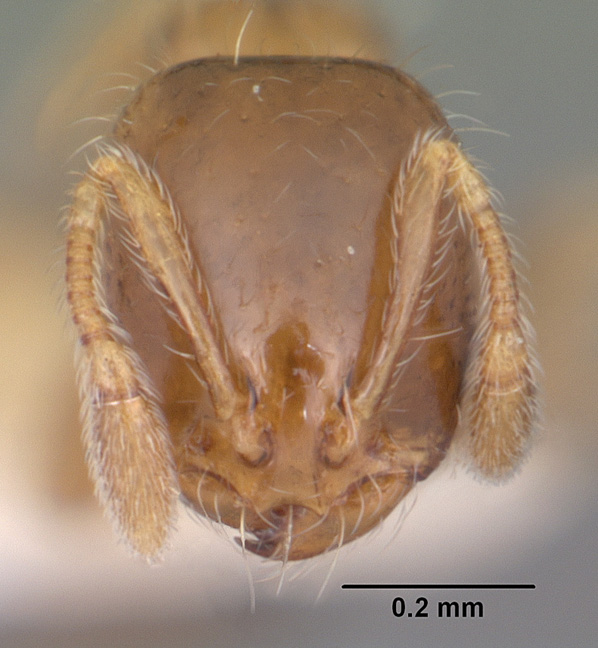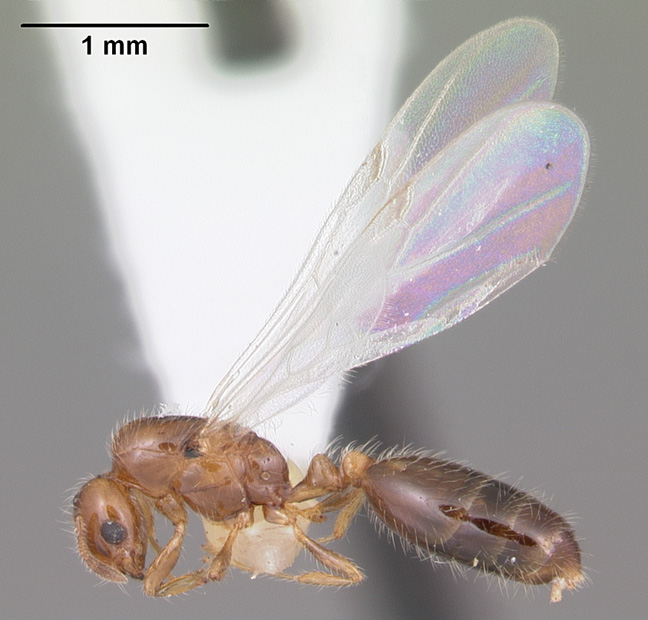Subfamily MYRMICINAE |
Solenopsis picta, full face view of a worker (click image to enlarge). Photo courtesy of http://www.antweb.org/ |
Solenopsis picta, side view of a worker (click image to enlarge). Photo courtesy of http://www.antweb.org/ |
Solenopsis picta, side view of a queen (click image to enlarge). Photo courtesy of http://www.antweb.org/ |
Introduction Solenopsis picta are small, brownish colored, arboreal nesting species that appear to be confined to the Southeast. Identification Hybridization is not uncommon among the larger fire ant group, which can make identification of some species difficult. Identification of thief ants is perhaps even more challenging due to their minute size, similar appearance of workers of one species to another, taxonomic problems, and lack of knowledge of all castes. Worker: SIze, minute (1.3 to 1.45 mm in total length). Coloration: concolorus brown to bicolored with a head reddish brown to darker brown, alitrunk reddish brown, and gaster dark brown; appendages yellowish brown to reddish brown. The eyes are small with 4-5 facets and almond shaped. A well developed metanotal suture is present. The node of petiole is placed anterior to the petiolar-postpetiolar juncture giving the petiole a distinct slender posterior peduncle. Female: SIze, small (about 3:24 mm in total length), slender, concolorous golden brown to darker brown. Head longer than wide, with fine punctures, angulate lateral clypeal teeth and lacking extralateral teeth. Pronotum finely puncture, with smooth, shiny sculpture; mesopleuron smooth, shiny; and metapleuron with horizontal striae. Petiole wider than postpetiole (in lateral view); petiolar node somewhat triangular and rounded; postpetiolar node oval and globose; and petiole and postpetiole lacking ventral tooth or flange (female description from Pacheco 2007). Male: Unknown? This species is one of the few thief ants that is unlikely to be confused with other species in the Southeast. The only other brown colored species are S. nickersoni and S. truncorum. Solenopsis nickersoni has only been reported from Florida and is thought to be a subterranean nesting species. Workers are smaller (about 1.2 mm TL), have pale yellow appendages and do not have the appearance of having a posterior petiolar peduncle. Queens are reddish brown and larger than queens of S. picta. Solenopsis truncorum is also only known from Florida. Workers are reddish brown and much larger in size than picta. Biology and Economic Importance I collected a series of workers at peanut butter bait on Quercus nigra. Hundreds of workers were present, although the nest location was not located. Members of the MEM have collected this species in a variety of habitats including bogs, mixed pine/hardwood forests, open maritime forests along the Mississippi Gulf Coast, steep sloped upland forests, and bottomland hardwood forests. Distribution Literature Cited Links |





